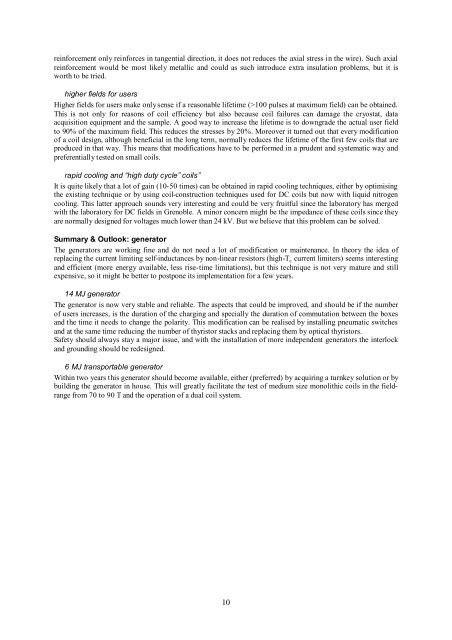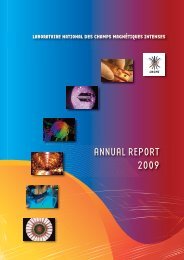Laboratoire National des Champs Magnétiques Pulsés CNRS – INSA
Laboratoire National des Champs Magnétiques Pulsés CNRS – INSA
Laboratoire National des Champs Magnétiques Pulsés CNRS – INSA
Create successful ePaper yourself
Turn your PDF publications into a flip-book with our unique Google optimized e-Paper software.
einforcement only reinforces in tangential direction, it does not reduces the axial stress in the wire). Such axial<br />
reinforcement would be most likely metallic and could as such introduce extra insulation problems, but it is<br />
worth to be tried.<br />
higher fields for users<br />
Higher fields for users make onlysense if a reasonable lifetime (>100 pulses at maximum field) can be obtained.<br />
This is not only for reasons of coil efficiency but also because coil failures can damage the cryostat, data<br />
acquisition equipment and the sample. A good way to increase the lifetime is to downgrade the actual user field<br />
to 90% of the maximum field. This reduces the stresses by 20%. Moreover it turned out that every modification<br />
of a coil <strong>des</strong>ign, although beneficial in the long term, normally reduces the lifetime of the first few coils that are<br />
produced in that way. This means that modifications have to be performed in a prudent and systematic way and<br />
preferentially tested on small coils.<br />
rapid cooling and “high duty cycle” coils”<br />
It is quite likely that a lot of gain (10-50 times) can be obtained in rapid cooling techniques, either by optimising<br />
the existing technique or by using coil-construction techniques used for DC coils but now with liquid nitrogen<br />
cooling. This latter approach sounds very interesting and could be very fruitful since the laboratory has merged<br />
with the laboratory for DC fields in Grenoble. A minor concern might be the impedance of these coils since they<br />
are normally <strong>des</strong>igned for voltages much lower than 24 kV. But we believe that this problem can be solved.<br />
Summary & Outlook: generator<br />
The generators are working fine and do not need a lot of modification or maintenance. In theory the idea of<br />
replacing the current limiting self-inductances by non-linear resistors (high-T c current limiters) seems interesting<br />
and efficient (more energy available, less rise-time limitations), but this technique is not very mature and still<br />
expensive, so it might be better to postpone its implementation for a few years.<br />
14 MJ generator<br />
The generator is now very stable and reliable. The aspects that could be improved, and should be if the number<br />
of users increases, is the duration of the charging and specially the duration of commutation between the boxes<br />
and the time it needs to change the polarity. This modification can be realised by installing pneumatic switches<br />
and at the same time reducing the number of thyristor stacks and replacing them by optical thyristors.<br />
Safety should always stay a major issue, and with the installation of more independent generators the interlock<br />
and grounding should be re<strong>des</strong>igned.<br />
6 MJ transportable generator<br />
Within two years this generator should become available, either (preferred) by acquiring a turnkey solution or by<br />
building the generator in house. This will greatly facilitate the test of medium size monolithic coils in the fieldrange<br />
from 70 to 90 T and the operation of a dual coil system.<br />
10







